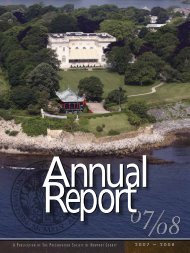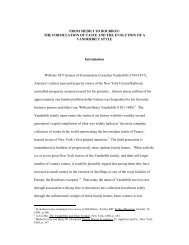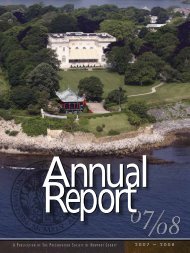The French Connection: Developing a Conservation Treatment Plan ...
The French Connection: Developing a Conservation Treatment Plan ...
The French Connection: Developing a Conservation Treatment Plan ...
Create successful ePaper yourself
Turn your PDF publications into a flip-book with our unique Google optimized e-Paper software.
In 1664, Louis XIV’s financial minister Colbert set up the Compagnie des Indes Orientales, in order to<br />
institute their own Asian trade. <strong>The</strong> Compagnie headquartered in Siam where they worked with Chinese<br />
traders, and eventually settled in Canton when that port was opened in 1699 to foreigners. In 1700, for<br />
example the cargo of one voyage, sold at Nantes, included “45 trunks of screens” which was called<br />
“vernis de la chine Amphitrite” [13].<br />
<strong>The</strong> marchands merciers, may have ordered direct but did also buy at auction; one merchant bought at<br />
St. Malo from the vessel Comte de Toulouse, in 1720, “five cases containing sixty leaves, four<br />
containing ninety six, and two containing fifty four, making a total of thirty five screens @400 livres – a<br />
year’s pay for skilled manual work in Paris -- or 14,000 livres worth of lacquer screens, probably<br />
Chinese [14]. It is perhaps notable that some of the lacquer panels are referred to as “feuilles” (leaves)<br />
instead of “paravents” (screens) suggesting that their importance was as raw materials rather than<br />
decorative object themselves. In any case, it is quite a lot of lacquer and there was clearly a busy and<br />
lucrative pathway to France.<br />
<strong>The</strong> furnisher of the Elms interior was the Parisian decorator Jules Allard (1832-1907). He attended the<br />
École des Arts Décoratifs, took over the family furniture manufactory, and eventually provided<br />
complete interiors, including furnishings, sculpture, hangings, and mounted paintings. Allard was an<br />
antiques dealer as well as a salvager and collector, acquiring architectural materials from demolished<br />
châteaux and hotels. Through collaborations with Richard Morris Hunt, the first American architect to<br />
attend the École des Beaux Arts, he was introduced to New York (and Newport) society. He became<br />
known as the “Vanderbilt decorator”, a designation that led to work for others in society and the<br />
architects who served them, such as Trumbauer.<br />
By the 1890s Allard had an office in New York and had built a new factory in Paris. In it could be<br />
found quantities of architectural salvage – paneling, sculpture, ceiling and overdoor paintings, mirrors,<br />
mantels, and molds and plaster casts of historic ornament as well as lumber storage, woodcarving shop,<br />
cabinetmaking and chair shop, marquetry shop, metal and bronze workshops, and paneling shop. <strong>The</strong><br />
firm was fully prepared to address all the decorative arts needs of their clients, including the fabrication<br />
of new boiseries from in-house designs and to repair, restore, or rework historic paneling [15].<br />
As a collector of historic materials, Allard could very possibly have come into the possession of a group<br />
of lacquer panels, perhaps custom ordered by a marchand mercier and subsequently salvaged from an<br />
eighteenth century Parisian townhouse. <strong>The</strong> firm would have been perfectly capable of processing the<br />
antique panels as necessary and providing a fourth to match. Unfortunately, no relevant company<br />
records have been found.<br />
Description<br />
All the large panels show scenes and landscapes common on screens from the seventeenth and<br />
eighteenth centuries. In each case, a large central scene is enclosed by a narrow gilded border. At the<br />
perimeter of the panel are cartouche panels depicting landscapes, Spring scenes from nature, and in the<br />
bottom corners, the mythical creature Qilin, wreathed with “heavenly fire”, who symbolizes longevity,<br />
goodness, wealth, compassion, and wisdom. <strong>The</strong> order of the cartouches is nearly the same for all the<br />
panels. <strong>The</strong>re is a final gilded border surrounding the cartouches with lotus flowers and calligraphy-like<br />
4





